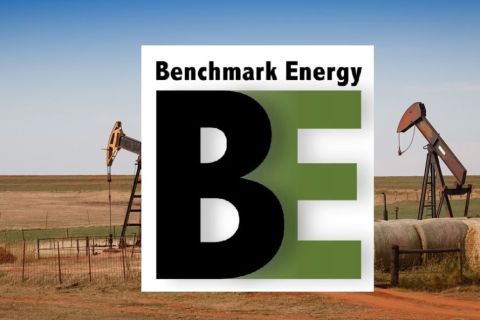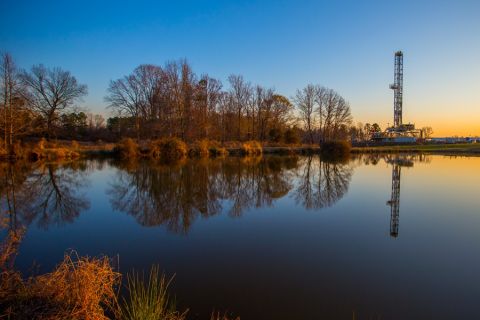The primary target of a recent deep gas exploration campaign in the K-field of northern Oman (Figure 1) is a tight Cambrian sandstone at 4,500 m to 4,800 m (14,850 ft to 15,840 ft) true vertical depth subsea, where Petroleum Development of Oman (PDO) has encountered a growing number of drilling challenges.
The 17½-in. surface section, for example, penetrates a series of dolomitic limestones and a thick mudstone that causes borehole stability problems due to swelling. The 12¼-in. openhole section typically penetrates more than 2,700 m (8,910 ft) of carbonates mixed with clastics, evaporates, and highly reactive shales. Drilling these complex formations resulted in low ROPs, bit balling, tight holes, stuckpipe, and twist-offs. In the 8-3/8-in. section, which consists almost exclusively of hard, abrasive sandstones, high downhole torque induces weak points and loading of the drillstring, while shock and vibration reduce ROPs. This HP/HT environment requires a high mud weight to maintain overbalanced drilling.

FIGURE 1. A location map and structural cross section of the K-field in northern Oman is shown. (Images courtesy of PDO and Schlumberger)
In recent years increasing well complexity, deteriorating performance, escalating costs, and nonproductive time (NPT) meant that deep gas exploration in the field could have become uneconomic. To exploit these vital resources more efficiently, PDO needed a step change in drilling optimization. Implementing a series of optimization strategies led to dramatic improvements and set a new performance benchmark for subsequent projects in HP/HT tight gas drilling environments.
Initial drilling optimization strategies
Initiatives to optimize drilling performance began with restructuring of the gas exploration team. In the past a single engineer had planned, designed, and managed the execution of each well from start to finish. However, earlier wells had been in shallower fields and less complex formations. To manage increasingly challenging HP/HT deep gas wells, PDO added planning and design engineers to the team. By dedicating resources to well design, operations engineers were freed up to focus on efficient execution, while synchronizing with the rest of the team.
The reorganized gas exploration team implemented several initial optimization strategies. They upgraded rigs from kelly to top-drive systems, standardized on a slimmer well design by deploying new casing-while-drilling technology in the surface section, enhanced the composition of water-based mud, and switched from water-based mud to high-performance oil-based mud in other sections. These changes eliminated one whole casingstring and allowed PDO to drill smaller, deeper holes while reducing the effects of reactive shales and improving ROPs.
Nevertheless, NPT caused by lateral, torsional, and axial vibrations, as well as stick/slip remained problematic. Improper bottomhole assembly (BHA) and bit design still caused tool failures, suboptimal ROPs, and numerous bit trips.
Added collaborative optimization strategies
To further improve performance, PDO established a collaborative partnership with Schlumberger. For a 2011 drilling campaign the joint team implemented three additional optimization strategies.

FIGURE 2. BHAs were optimized for a 12¼-in. section and an 8?-in. section.
Finite element analysis and dynamic modeling. Severe drillstring dynamics – shock, vibration, and stick/slip – can expose drill bits, logging and measurement tools, rotary steerable systems, drill collars, and drillpipes to catastrophic failures. These can lead to costly NPT, lost down-hole equipment, and even lost holes. The first step in improving drilling performance, therefore, was to better manage drillstring dynamics. Using finite element analysis and 4-D modeling, the Smith Bits i-DRILL engineered drilling system design software brought together offset well data and surface and downhole measurements to create a virtual simulation of the entire drilling system in this particular field’s downhole environment.
Finite element analysis identified ways to minimize vibrations and stick/slip. The smart simulator also designed an integrated BHA solution combining the right downhole drive system with the right bit and provided advanced analysis of failures caused by drillstring behavior. The 4-D model was validated by comparison with the real-time drilling mechanics log in an offset well, which closely matched the simulator output.
BHA optimization. In previous wells improper stabilizer positioning had created harmful harmonic vibration in the drillstring, resulting in numerous runs in both the 12¼-in. and 8-3/8-in. sections, as well as twist-offs and lost-in-hole BHAs. Interbedded carbonates, reactive shales, and evaporates in the 12¼-in. section caused tight holes, damaged drillstring components, and initiated fatigue. High downhole drilling torque caused by abrasive formations in the 8-3/8-in. section led to weak points and excess loading of the drillstring.
To avoid wasting energy in the drillstring due to BHA instability, a packed assembly approach with a greater number of stabilization points at properly spaced intervals was chosen. This made it possible to drill longer sections with the least possible deviation in these deep, vertical wells. To monitor shock and vibrations and adjust drilling parameters in real time, a high-speed, high-resolution MWD tool also was incorporated into the BHA design (Figure 2).
Bit optimization. Bit design proved to be one of the most critical factors in drilling performance. In this part of the field the 12¼-in. section is typically 2,700 m to 2,850 m (9,350 ft) thick, penetrating 13 formations and five distinct lithologies with unconfined compressive strengths ranging from 3,000 psi to 33,000 psi. The 8-3/8-in. section penetrates about 1,800 m (5,940 ft) of abrasive clastics, shales, and streaks of limestone with an unconfined compressive strength (UCS) between 6,000 psi and 27,000 psi.
Drilling medium-to-hard carbonate formations with roller-cone bits required higher weight on bit, while the extended thickness of the 12¼-in. section required higher drilling hours. These two conditions caused premature failure of roller-cone cutting structures and shorter bearing life, requiring an excessive number of bit trips and associated NPT. Drilling with polycrystalline diamond compact (PDC) bits through interbedded soft and hard formations with vastly differing UCS also caused high axial and lateral vibrations, leading to premature failure of PDC cutting structures. The bottom part of the abrasive 8-3/8-in. section proved so challenging, it had been drilled mainly with impregnated bits.
Using the Smith Bits IDEAS integrated drill bit design platform, specialists quantified the forces between various PDC cutters and rock samples matching the specific formations to formulate relative rock removal rates. For each challenging hole section, the customized bit design process accurately identified advanced PDC cutter technologies to achieve greater impact resistance and less wear while drilling longer intervals at faster ROPs under actual drilling conditions.

FIGURE 3. Time-depth curves for well K-04 show improvements compared to the best previous offset well.
Results of 2011 optimization campaign
Drilling the 12¼-in. section in previous wells had required up to 16 roller-cone and PDC bits. Well K-04, the first well drilled with optimized bits and BHAs, required only two PDC bits to drill the 2,765-m (9,124-ft) section, improving ROPs over 70% and reducing drilling time by more than 15 days compared with the best previous offset run (Figure 3). PDO also achieved its longest PDC run in the 8-3/8-in. section. It took six advanced PDC bits to penetrate 1,800 m of the abrasive, HP/HT target formation, resulting in time savings of 10 days.
In this and one other 2011 well in which advanced PDC bits were integrated with optimized BHAs, PDO saved a total of 25 days per well – a new benchmark against which to measure subsequent drilling performance under similar conditions. Reducing drilling time by 25 days saved PDO US $1.25 million per well, for a cost that was 22% lower than previous well costs.
Collaborative design, simulation, and optimization of bits and BHAs under actual drilling conditions, combined with optimized drilling parameters and best practices in well delivery, resulted in dramatic performance improvements in this deep tight gas field in Oman.
This article is based on SPE/IADC Paper 163505, which was presented at the SPE/IADC Drilling Conference in Amsterdam in March 2013.
Recommended Reading
EIA: Permian, Bakken Associated Gas Growth Pressures NatGas Producers
2024-04-18 - Near-record associated gas volumes from U.S. oil basins continue to put pressure on dry gas producers, which are curtailing output and cutting rigs.
Benchmark Closes Anadarko Deal, Hunts for More M&A
2024-04-17 - Benchmark Energy II closed a $145 million acquisition of western Anadarko Basin assets—and the company is hunting for more low-decline, mature assets to acquire.
‘Monster’ Gas: Aethon’s 16,000-foot Dive in Haynesville West
2024-04-09 - Aethon Energy’s COO described challenges in the far western Haynesville stepout, while other operators opened their books on the latest in the legacy Haynesville at Hart Energy’s DUG GAS+ Conference and Expo in Shreveport, Louisiana.
Mighty Midland Still Beckons Dealmakers
2024-04-05 - The Midland Basin is the center of U.S. oil drilling activity. But only those with the biggest balance sheets can afford to buy in the basin's core, following a historic consolidation trend.
Mesa III Reloads in Haynesville with Mineral, Royalty Acquisition
2024-04-03 - After Mesa II sold its Haynesville Shale portfolio to Franco-Nevada for $125 million late last year, Mesa Royalties III is jumping back into Louisiana and East Texas, as well as the Permian Basin.





